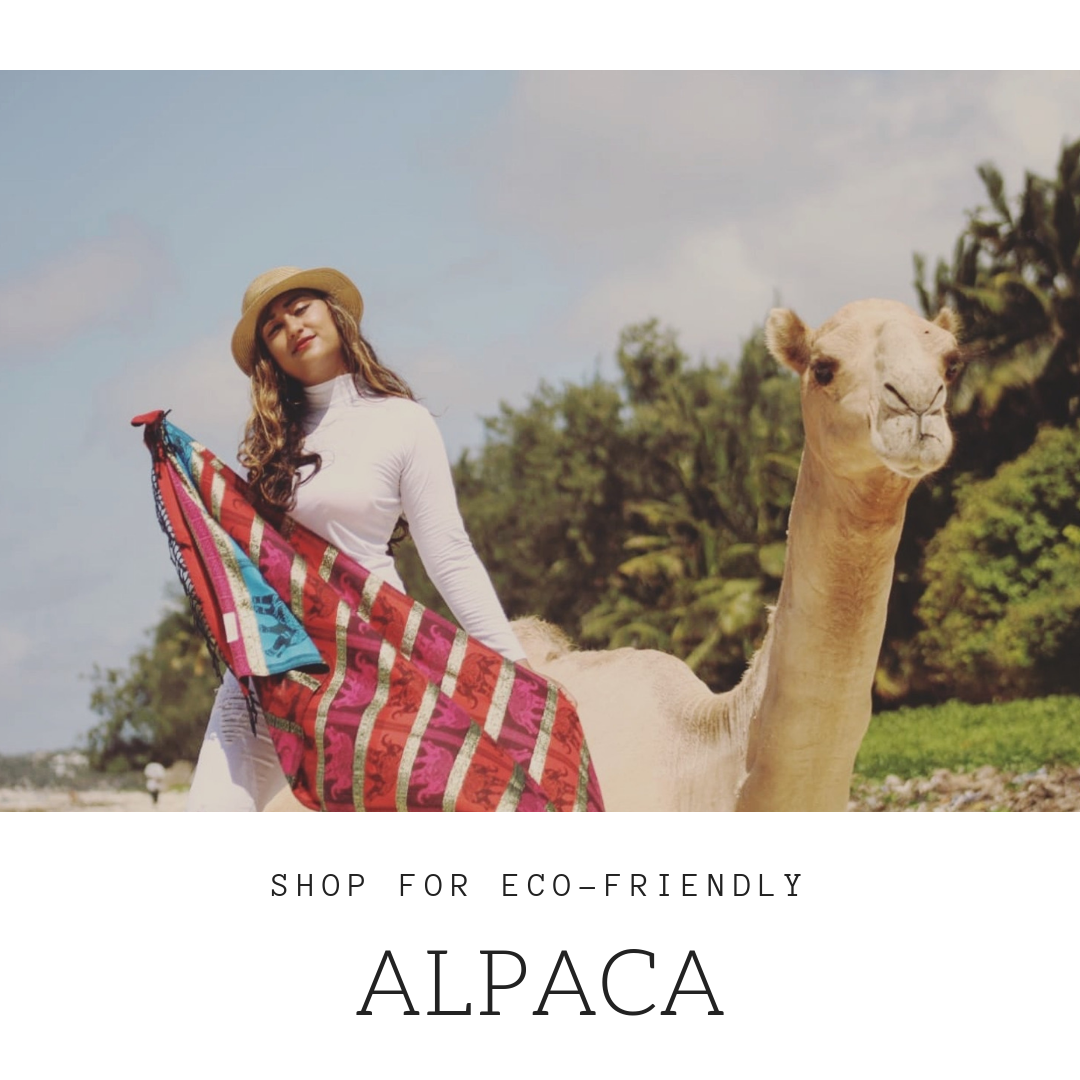
Peruvians had been in on the secret for centuries. The luxurious fleece of the Alpaca was considered the “Gold of the Andes” by the ancient Inca civilization and remains an important cultural symbol. The Alpaca’s valuable wool lead to the development of a thriving textile industry. Artisan weavers, using the Alpaca Wool as a source of fiber for their colorful weaving, became an integral part of society and has provided a valuable source of income for farmers and their families for generations.
The Fashion industry has taken notice as they look to meet the demands of the fashion-conscious consumer now demanding greater transparency such as the “who made my clothes” movement. They are looking for greener, more sustainable, eco-friendly but still fashionable garments.
So why is Alpaca the ultimate sustainable luxury wool?
1. ALPACA IS LUXURIOUS, VERSATILE & FASHIONABLE WOOL

Alpaca wool has a soft, durable, luxurious and silky natural fiber. It is extremely versatile and can be used on its own or blended with other sustainable fibers such as silk or bamboo to create a wide variety of goods such as clothing, hats, bedding, rugs, baskets & toys.
It is the warmest and softest natural fiber available. Alpaca wool’s naturally insulating core keeps you warm without weighing you down. it’s Hypoallergenic, a big plus for those with sensitivities to wool as it contains no lanolin.
Color options are endless as Alpaca wool comes in 22 natural colours including variations of white, grey, brown and black and can be blended to create more than 300 shades. For more vibrancy, Artisans use centuries-old natural dyeing methods utilizing materials that are derived from natural resources, such as plants, flowers, fruits, animals, insects, and minerals.
Garments are long-lasting and won’t shrink or pill if given correct care. And Care is Easy – simply hand wash with a mild detergent and lay flat to dry.
ALPACA VS CASHMERE (5 FAST FACTS)
- Alpaca yarn is considered more luxurious, slightly softer, lighter and warmer thanks to its longer fibers. Second only to silk for strength due to the length of the wool fibers
- Cashmere is no longer considered sustainable due to both to the glut of Cheap Cashmere (mass production in China) combined with ongoing environmental factors affecting the cashmere goat herds
- Both Alpaca & Premium Cashmere are hypoallergenic as it has no lanolin content.
- Cashmere tends to pill and does not have the same longevity
- Alpaca garments are often less expensive than premium cashmere
Bottom line. Alpaca is a fantastic investment in your wardrobe!
2. THE ECO-FRIENDLY ALPACA HAS A LIGHT ENVIRONMENTAL FOOTPRINT

Alpacas are the South American cousins of camels and llamas (camelids) and native to the Andes in South America. Today there are about 3.5 million alpacas in the Andean highlands, most of which can be found in the altiplano (highlands) of Peru. Alpacas are raised on thousands of small independent family farms. The flock is usually shorn once a year in late spring and used directly for Artisan weaving or sold in bulk at market.
The Alpaca just might be the greenest animal on the planet. This is why:
Light Footprint: They eat mostly (native) grass, and sometimes leaves wood, bark or stems. Unlike other grazers, alpacas do not decimate natural vegetation plus they eat a whole lot less. An Alpaca will consume approximately 1.5 percent of their body weight each day. As a result, you can keep far more alpacas on the same amount of land then sheep
Low Impact: their soft, padded feet are gentle on the terrain and they graze without destroying root systems.
Adaptable: The alpaca has a very fine and light fleece. It does not retain water, is a thermal insulator even when wet and can resist solar radiation effectively. They are hardy, typically residing in very harsh climates and seem to adapt easily to most climates, elevations, and conditions.
No HARM: Alpacas are shorn once a year providing farmers with a valuable source of income, but it also benefits the alpaca by removing fleece prior to the warm summer months to avoid heat stress.
Communal Bathrooms: Alpacas in a herd all use the same area as a bathroom, helps control parasites. Bonus: Their waste droppings make an amazing, all-natural fertilizer.
Very Social: Alpacas are very social creatures gentle and curious and with training can become great pets.
~ So darn cute and fun to be around! ~
3. CHOOSING ALPACA PRODUCTS SUPPORTS ECONOMIC, SOCIAL AND ENVIRONMENTAL DEVELOPMENT

The native habitat of Alpacas is the “Altiplano” located in the Peruvian Andes, a cold and dry high mountain desert that is very windy and almost barren. For centuries thousands of indigenous communities’ sole means of survival was breeding alpacas for their valuable wool. Families & members of the community worked together to raise the herds, complete the shearing process then eventually spinning the valuable Fiber into Yarn that was then crafted into wonderful bright and colorful textiles.
This traditional way of life continues today. Despite extreme climatic conditions, very basic living conditions, and still limited economic opportunities, at least one and a half million people living in the highlands of the Peruvian Andes still rely almost exclusively on the breeding of Alpacas for their livelihoods.
The Fair-Trade movement with the help of Cooperatives & Collectives is bringing about change to these communities. Projects are underway to aid farmers in modern agriculture practices such as pasture management, husbandry, business management, and associated marketing to access new markets. It is important to note that family farms working as a collective allows them to get a guaranteed better price for their wool.
Through the support of these Coops, Women are also able to contribute in a significant way to their family’s prosperity and children’s education. Further, these weaving co-ops help these communities maintain their traditional weaving techniques which have been passed down from generation to generation. Indigenous communities can preserve their history and culture by weaving the stories of its people using their unique iconography and patterns into their colorful textiles.
Choosing Alpaca wool products will help support this traditional farming and weaving sectors while allowing families to continue their traditional lifestyles. Your support contributes to the economic and social development of these communities and furthers the educational opportunities for children.
So, go ahead and treat yourself to an affordable Eco-Friendly luxury.



332 comentarios
aZqKIWlwY
ZYbCTfvkXdnx
JcYmnWQrw
LvfbaxBGNHmKE
lBPgnxeUofA